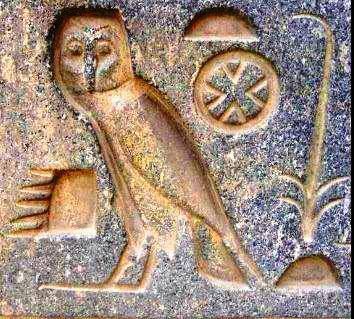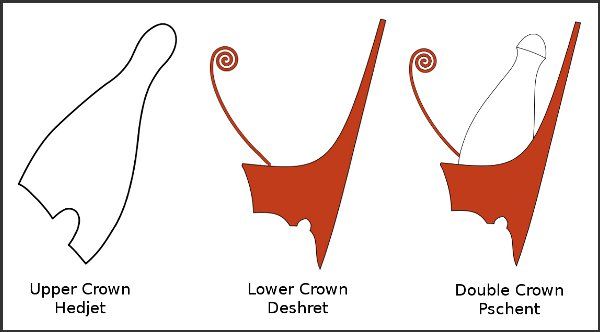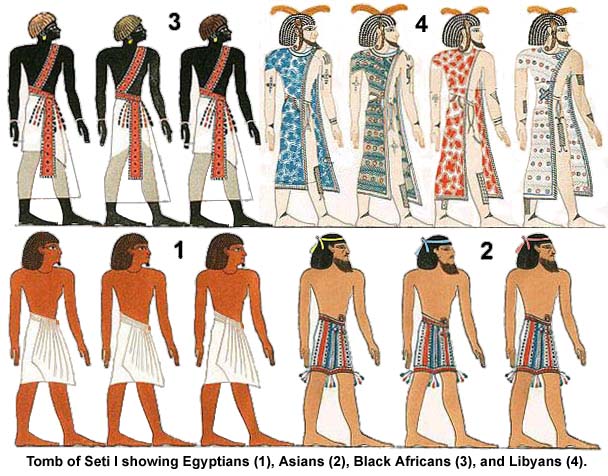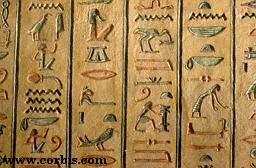One of the most common arguments used to defend the hypothesis of a black origin of the ancient Egyptians is that they called themselves km.t .
The meaning of Km.t, according to Cheikh Anta Diop
According to Cheikh Anta Diop (1980: 61-62), following a discovery made by Sossou Nsougan, this term etymologically means « the Negroes ». The Senegalese scholar expressed himself in this regard in the following terms:
« It is the strongest term in the Pharaonic language to indicate blackness; it is therefore written with a hieroglyph which represents a piece of wood that has charred and not crocodile scales. This word is the etymological source for the famous root kamit which has proliferated in modern anthropological literature. The biblical root ham would derive from it. It was therefore necessary to distort the facts so that it could mean today « white » in the language of scholars while, in the Pharaonic tongue which gave birth to it, it meant charcoal black. In the Egyptian language, one forms a collective from an adjective or a noun by putting them in the feminine singular. Km.t has been formed like this, from the adjective = km: black; it therefore means, rigorously, the Negroes or at least the Blacks. The term is a collective which thus designates all the people of Pharaonic Egypt as black people. In other words, from a purely grammatical point of view, if we want to designate Negroes in the Pharaonic language, we cannot use any other word than the very one the Egyptians used to designate themselves. «
Whether or not the hieroglyph with the phonetic value km represents a « piece of wood that has charred » or « crocodile scales », the root km represented by this hieroglyph does indeed denotes blackness.

This term is attested in Erman and Grapow’s Wörterbuch. However, it only appears in one and same text, a hymn to King Sesostris III. This is km.t.
The fact that it appears twice with the same spelling in the same text suggests that this is probably not a scribal error. This term is distinguished from the more frequent self-names of Egyptians and their country, namely kmtjw, rmṯ n Km.t and km.t.
Kmtjw means ‘those of the Black’ and rmṯ n Km.t ‘people of the Black One’. The difference between Km.t ‘Egypt’ and Km.t ‘Egyptians’ rests on the nature of the determinative of the second, which represents a man and a woman, as well as the three traits marking the collective.
Generally, when km.t ‘Egypt’ is used, it is with the determinative of the city (sign 049), without determinative or with that of the cultivated land (sign N23), not with that of the man and the woman. Goelet (1999: 36-37) analyzed the occurrences of this exceptional form of km.t.
jj.n.f n.n ḥk3.n.f Km.t (?) rdj.n.f dšrt m ʿb.f jj.n.f n.n mkj.n.f t3wy sgrḥ.n.f jdbwy jj.n.f n.n sʿnḫ.n.f Km.t (?) ḫsr.n.f šnww.s
It was (after) he had ruled the (people of ?) Egypt (lit., the Black Land),
and (after) he had put the Red Land in his company, that he came to
us.
Diop explains that there is a priori a possibility that the word km.t « Egypt » is a reference to the black soil as it is often stated in Ancient Egyptian literature.
However, he denies this possibility, explaining that the collective km.t ‘Black people’ shows that the color applies to the determinative and that therefore, in the context of km.t ‘Egypt’, the reference to the blackness of the soil must be secondary compared to that of its inhabitants like in the expressions ‘Black Africa’ or ‘Nigritia’.
According to Diop, the same is true of the term kmtjw often used to refer to the Egyptians, which would be comparable to the expressions « the inhabitants of Black Africa » and « the Nigritians » which both designate black populations. Diop unfortunately does not take into account another hypothesis according to which km.t is both a reference to the color of the Nile silt and the inhabitants of Pharaonic Egypt.
Etilé (2003) : Gender incompatibility as an argument for Km.t not being a reference to the colour of the soil?
One of his followers, Etilé (2003: 47) pointed out what he believed to be the impossibility for km.t and related terms referring to Ancient Egypt and its inhabitants to be references to the Egyptian soil blackened by the silt of the Nile. This author explains that there is a gender incompatibility between the Egyptian term for ‘earth’ t3, which is masculine and the determinative of km.t, which he says is the 049 sign of the city and whose phonetic value is njw.t, a feminine word.
This gender distinction between the Egyptian word for ‘land’ and the Egyptian name km.t has also been noted by Vycichl (1984: 81). According to this author, a hypothetical Egyptian feminine word for ‘earth’ different from t3 would have been qualified by km.t ‘black’ before the latter was nominalized:
« The implied word is, in these cases, not t3 ‘land’, but a feminine noun, as in Semitic (Arabic 3ard), Berber (chelha tamurt) and Cushitic (Bedja bur). «
According to Etilé, km.t would therefore be in agreement with njw.t and his feminine gender. The observation is interesting, but incomplete. Goelet (1999: 30) reports that:
« The first nonliterary sources mentioning Kmt seldom employ, the‘ town « sign (Sign-list O49) associated with cities and settlements. Most of these early examples of Km.t either write the word with no determinative or else with the ‘cultivated land’ sign (Sign-list N23) and frequently have Kmt in parallelism with some word for the Dšrt ‘the Red Land’, thus setting a pattern followed throughout Egyptian history ”.
The sign of « cultivated land » (N23) is used as a determinative of the words t3 « land » and j3š « border » which are both masculine. Etilé’s hypothesis is weakened since a sign for ‘cultivated land’ appears in Egyptian writings to determine kmt Egypt’. So there was not, at least not always, an opposition between kmt « the Black One, Egypt » and the cultivated land for the Pharaonic Egyptians.
Furthermore, it is quite possible that Kmt, as a later nominalized adjective, would have been used to qualify a word for land which would have been lost in usage at the time of Kmt‘s first written attestations. A parallel situation deals with ancient Egyptian words which have disappeared and are no longer attested except as signs whose meaning can be deduced by their appearance, the elements they determine and the parts of words used to write them.
This is the case, for example, of a word for ‘eye’ in Egyptian, which Egyptologists have reconstructed as *ʿn. This word, which is traditionally connected to the Proto-Semitic word * ʿjn appears in Egyptian in the form of the signs D7 and D8 which represent respectively a eye with make up and an eye (without make-up; contra Mboli 2010:204) circled in the sign to designate a country.
It is therefore believed that speakers of Proto-Egyptian used a word meaning ‘eye’ which has not survived in the literature, and possibly the language of the Old Kingdom and earlier periods.
Likewise, speakers of Proto-Egyptian could have used a lost feminine word for « land » which in their time would have been qualified by the feminine adjective km.t.
Another argument mentioned in another paper and in favour of the hypothesis of km.t being a reference to the black color of the Nile silt can be found in an ancient Greek text. This is a passage from Isis and Osiris, written by Plutarch. In this text, chapter 33, the author reports as follows:
“In addition, Egypt is named, because its lands are black among all, like the black of the eye, Khemia. «
Certainly, we must distinguish the etymology of a word and its meaning at some point in time; we cannot say at this stage of the demonstration whether the fact of using the color black to call their country from the land of Egypt has preceded, in the use of the Egyptians, that of the skin of its inhabitants.
The opposite case, which would have seen the Egyptians explain the color of their skin by that of their land, in any case finds an interesting parallel in a neighboring and contemporary cultural universe of Pharaonic Egypt and the period preceding its formation, that of Proto Semitic speakers.
The red earth and man in Semitic
In his work on the prehistory of Semitic languages, Diakonoff (1981: 55) recalled the derivation of Semitic words for « red », « man » and « earth » from the same Proto-Semitic root * ʾdm.
He reported, in particular, that the Hebrew words ʾādām ‘man’, ʾădām-at ‘earth (red)’ and ʾdm ‘to be red ‘are derived from it. In the other most famous Semitic language, Arabic, we find this root ʾdm with the roots and words ʾdm ‘to be brown’, ʾadīm ‘skin’, ʾadam(at) ‘human skin’, ʾiʸdāmat ‘hard ground, without stone’.
In agreement with the biblical account in which Adam, the first man is created from the earth, Diakonoff explains that the etymological relationship between the red earth, man and his skin comes from the fact that God would have created the human being from of the red earth and that the first speakers of Semitic languages or their ancestors would have considered themselves to have ‘red’ skin.
The Russian linguist extends this self-identification of ‘red (skin) people’ to Ancient Egyptians.
He first does so on a linguistic basis by claiming that the Semitic root *ʾdm to ‘be red’ is related to the Egyptian word for ‘skin’, jnm. He then does so based on representations of men in ancient Egyptian art, which he describes as « red-brown ». The ancient Egyptians, he said, would have considered themselves to be « red-skinned », like the first speakers of the Semitic language.
Diakonoff’s hypothesis is problematic in many ways. The Semitic root * ʾdm is probably not related to the Egyptian jnm ‘skin’. It is more likely related to the Egyptian jdm.j ‘red linen’ (Takacs 1999:120) Nor is the idea of redness intrinsically associated with the Egyptian word jnm.
It is much more likely that the latter is related, for example, to the Berber * i-ylim « skin » for which the phonetic correspondences and the meaning make it a perfect parallel.
Another problem is the following. In English, the color adjective used to refer to the skin of ancient Egyptian men is the same used to refer to the color of blood and bricks. These are red and reddish-brown. Diakonoff seems to assume that this was necessarily the case in ancient Egyptian.
Several examples show that this was not always the case. In ancient Egypt, the crown of Upper Egypt was called ḥḏt traditionally called, while the red crown was called dšrt. These two terms referred to the white and red colors of the two crowns. In contexts comparing them, the red is presented as « kmt jmjt = sny », literally the « darker » (kmt) of the two (crowns).

In this specific case, in comparison with the white crown, the red crown has been described with the word km, most often translated as « black », but which would therefore rather mean « dark » in this context (Goebs 2008:159).
Several researchers dealt with colors in the ancient Egyptian language. This is the case of Schenkel (1963, 2007). Schenkel (1963) notes that the word dšr, which is generally translated as rot in German (‘red’ in English), could also define realities that he would describe with the German term gelbrote (‘red-orange’ in English), like the Egyptian desert, even gelb (‘yellow’ in English). This author also notes that there was originally no term for German gelb (« yellow ») in Egyptian.
Similar things can be said, according to Schenkel (1963), of the word km, which he translates as schwarz (‘black’). but which can according to him also mean braun (‘brown’), rotbraun (red-brown), dunkel ( dark) or grau (‘gray’). Interestingly, the only example that leads Schenkel to give km the value of braun and rotbraun is when it is applied to harvesters.
Hannig’s Wörterbuch (2003: 1359) gives us more details on this meaning of the term km. It is used before ḥ3.t forehead ’, the whole translating, according to Hannig, to brown-colored foreheads (of laborious harvesters browned by the sun)’ = (mit brauner Stirn (fleißiger, sonnengebraünter Ernte Arbeiter). I follow Schenkel and Hannig translation of km in this case as ‘brown’, but which of course, could have as well as been translated by ‘black’ without any prejudice about the possibility of Ancient Egyptians having charcoal-like black skin.
The reddish-brown color characteristic of the skin of Egyptian men in Pharaonic art, mentioned by Diakonoff and which he supposes would have been translated into the Egyptian language as a cognate of Semitic * ʾdm ‘to be red’, is in fact translated by the Egyptian km ‘(to be) black’. The latter is rather cognate within Semitic, with Syriac: ʾukkāmā ‘black’ and Talmudic Hebrew: ʾukkām ~ ʾukkāmā ‘black’ (Takacs 1999 : 219).
Diakonoff points out that there is no red soil in Southwest Asia except in northern Anatolia, where Semitic has never been spoken.
Yet it was very likely in Southwest Asia that Proto-Semitic emerged. On the other hand, in Africa, the color of the soil is typically ‘red’ with the exception of the Nile Valley, whose soil is black because of the sediments of the White Nile, hence the name km.t of the Egypt.
He deduces that the development of the myth of the creation of the red man from the red earth present in the Bible must have developed in Africa in a language from which Semitic and other related languages such as Egyptian and Berber would have proceeded.
If this was the case, we should find traces of this belief in Berber and Egyptian. Sarnelli (1957), proposed that (a) maziɣ, the ethnonym used by many Berber speakers to refer to themselves was derived from the Berber root zwɣ ‘to be red’, combined with a prefix m- marking agent nouns, the meaning of the combination being ‘the one who is red’.
This hypothesis was rejected by Chaker (1986), who argued that the -w- in the root for ‘red’ never appeared in (a) maziɣ and its variants. Takacs (2008) rejected this objection, citing the ancient ‘Libyan’ ethnonym attested in Egyptian, mšwš, traditionally regarded as a reflex of (a) maziɣ.
Diakonoff presupposes, in our view correctly, that in order to be called « red » in reference to its members’ skin color, a linguistic community must have been living around another of a different skin color. He assumes that in this specific case, the Reds ’must have been confronted with ‘Blacks’ in the prehistoric Sahara to be called that way.
Some contemporary uses of (a) maziɣ and its variants seem to be part of this dynamic. They are in fact only applied to lighter-skinned populations as opposed to so-called Black or mixed populations.
Thus, although he considers this opposition as being a secondary development, Chaker (1986) reports that:
“In some Berber groups where there was a strong social stratification (Tuaregs) and / or a large (reputed) allogenous (negroid) population (southern Morocco, Algerian Sahara), the word Amaziγ used to specifically designate the White Berber, the free man, the nobleman or the suzerain (as among the southern Tuaregs), as opposed to black or mixed Berber speakers, of inferior social status (slaves, descendants of slaves, almost enslaved field workers, members of specific professional castes: musicians, butchers…) ”.
A similar argument can also be found regarding populations from North Africa west of Egypt, called by the Egyptians ṯmḥ.w. This ethnonym, attested as far back as the Old Kingdom, could be compared to the late Egyptian word ṯmḥj whose meaning was likely ‘red ochre’.
The stem hypothetically common to these two words, * ṯmḥ could be associated with the color red, confirming in a very fragmentary way Diakonoff’s hypothesis on a pre-Semitic origin of the idea of the formation of the red man from of the red earth among the first speakers of Semitic languages.
Black earth and people in Egyptian
If it does not confirm Diakonoff’s hypothesis on a pre-Semitic origin of this idea, the Egyptian language confirms its existence at the level of the Proto Semitic. The ancient Egyptians did not describe the red-brown skin of their men working in the sun with an equivalent word of « red » but with an equivalent word for « black ».
This term for black ’, km, was also used to describe the color of the soil of Egypt, due to silt, in the form kmt. Like ʾādām which was created and modeled from the red earth ʾădām-at, the Egyptians, kmtjw, rmṯ n kmt or km.t were created and modeled, according to a tradition recorded as early as the Fifth Dynasty, by Khnum, the ram-headed potter, from the silt of km.t.
This distinction between ancient Egyptians and contemporary Asiatic speakers of Semitic languages is often found in representations of the two by the former.

Asiatics often appear lighter skinned than Egyptians, especially Egyptian men, whose skin is conventionally painted reddish-brown as opposed to women, whose complexion conventionally ranges from white to yellow. That the conventionally reddish-brown complexion of Egyptian men prevailed over that of women in the Egyptian self-definition is shown by the fact that the hieroglyphics depicting body parts did so to the characteristic red-brown color of men and not, the lighter skin tone characteristic of Egyptian women.

Complementing this opposition between lighter-skinned Asiatics and darker-skinned Egyptians in the latter’s art, the Biblical tradition presents speakers of Semitic languages as the sons of Shem and the Egyptians as sons of Ham, that is as darker skinned populations.
As we saw earlier, the female gender of km.t (outside of the fact that toponyms are often treated grammatically as feminine nouns even if they are not marked as such) is an enigma, since the name originally refers to Egyptian soil, to land, and the word for these, t3, has a masculine gender in Egyptian.
Linguists generally recognize a special relationship between ancient Egyptian and Semitic. It would at least in part be the result of language contact, during the Neolithic, between populations of northern Egypt in direct contact with Southwest Asia, and populations further south. This contact would have led to Egyptian to share some striking similarities with Semitic.
Did these northern populations contribute to bringing this red (man) association created from the red (earth) into the Egyptian language?
If so, having arrived in a different geological environment where the soil was no longer red but black, they would have named their land km.t, the gender of the latter having been inspired by that of ʾădām-at ‘red earth’ and their demonyms km.t, ( kmtjw and rmṯ n km.t?) made possible by the generally darker skin tone of the Egyptians compared to contemporary speakers of Semitic languages.
This hypothesis helps to explain a number of facts that were not until now:
• Why were the ancient Egyptians called themselves Black if they did not (or very rarely if they ever did) call their darker-skinned southern neighbors in this way? Because this denomination was secondary to the name of the earth, and because it was motivated in the particular context of an adaptation / opposition to the red Semitic (earth) > (man) red in the genesis of the Egyptian.
• It reconciles the two hitherto contradictory theories of km.t ‘The Black One’ as a reference to the color of the soil and its inhabitants.
• It helps to explain why km.t, although it refers to a reality marked by a masculine gender, the earth, is marked by the feminine gender, through the influence of the Semitic ʾădām-at.
• It helps to explain the semantic match between km.t ‘Blacks’ and kmtjw Those of the black earth’ (as creatures formed from the black earth) and kmtjw ‘those of the Black nation’.
It is difficult to posit the opposite path from Egyptian to Semitic. Indeed, the Proto Semitic must have developed this association before arriving in his Asiatic homeland, in this case on the red African earth.
The etymological relationship between red, man and earth is no longer transparent in Proto-Semitic and must have preceded this state.
Furthermore, the gender of ʾădām-at is consistent with the feminine gender of earth in Semitic and does not need to be explained by that of km.t as would be the case for the latter.

